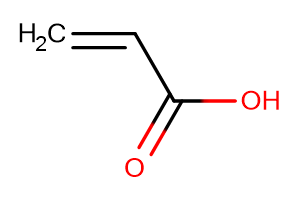
Acrylic acid
CAS No. 79-10-7
Acrylic acid( Ethylenecarboxylic acid )
Catalog No. M19691 CAS No. 79-10-7
Acrylic acid has been primarily detected in saliva. Within the cell acrylic acid is primarily located in the cytoplasm. Acrylic acid participates in a number of enzymatic reactions.
Purity : >98% (HPLC)
 COA
COA
 Datasheet
Datasheet
 HNMR
HNMR
 HPLC
HPLC
 MSDS
MSDS
 Handing Instructions
Handing Instructions
| Size | Price / USD | Stock | Quantity |
| 100MG | Get Quote | Get Quote |


|
| 200MG | Get Quote | Get Quote |


|
| 500MG | Get Quote | Get Quote |


|
| 1G | Get Quote | Get Quote |


|
Biological Information
-
Product NameAcrylic acid
-
NoteResearch use only, not for human use.
-
Brief DescriptionAcrylic acid has been primarily detected in saliva. Within the cell acrylic acid is primarily located in the cytoplasm. Acrylic acid participates in a number of enzymatic reactions.
-
DescriptionAcrylic acid has been primarily detected in saliva. Within the cell acrylic acid is primarily located in the cytoplasm. Acrylic acid participates in a number of enzymatic reactions. In particular Acrylic acid can be biosynthesized from acrolein; which is catalyzed by the enzymes retinal dehydrogenase 1 and aldehyde dehydrogenase dimeric nadp-preferring. In addition Acrylic acid can be biosynthesized from acrolein; which is catalyzed by the enzymes retinal dehydrogenase 1 and aldehyde dehydrogenase dimeric nadp-preferring. In humans acrylic acid is involved in the ifosfamide metabolism pathway the cyclophosphamide metabolism pathway the cyclophosphamide action pathway and the ifosfamide action pathway. Outside of the human body acrylic acid can be found in pineapple. This makes acrylic acid a potential biomarker for the consumption of this food product.
-
In Vitro——
-
In Vivo——
-
SynonymsEthylenecarboxylic acid
-
PathwayProteasome/Ubiquitin
-
TargetEndogenous Metabolite
-
RecptorHuman Endogenous Metabolite
-
Research Area——
-
Indication——
Chemical Information
-
CAS Number79-10-7
-
Formula Weight72.06
-
Molecular FormulaC3H4O2
-
Purity>98% (HPLC)
-
SolubilityDMSO:10 mM
-
SMILESOC(=O)C=C
-
Chemical Name——
Shipping & Storage Information
-
Storage(-20℃)
-
ShippingWith Ice Pack
-
Stability≥ 2 years
Reference
1.Liu Q. Wang Y. Wu L. Jing B. Tong S. Wang W. & Ge M. (2017). Temperature dependence of the heterogeneous uptake of acrylic acid on Arizona test dust.?Journal Of Environmental Sciences?53 107-112. doi: 10.1016/j.jes.2016.03.027
molnova catalog



related products
-
Methionine sulfoxide
Methionine sulfoxide can be regarded as a biomarker of oxidative stress in vivo.?Methionine sulfoxide is an oxidation product of methionine with reactive oxygen species.?
-
L(+)-Asparagine mono...
L(+)-Asparagine monohydrate is a non-essential amino acid participate in neurological and metabolic regulation of tissue cell function.
-
5-Hydroxytryptophol
5-Hydroxytryptophol is a metabolite of tryptophan.?It is used as a biomarker for recent alcohol consumption and causes sleeping sickness



 Cart
Cart
 sales@molnova.com
sales@molnova.com


